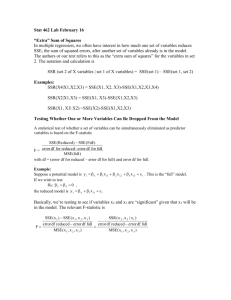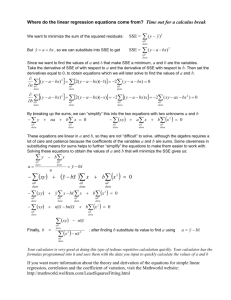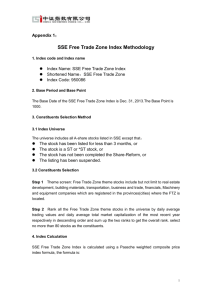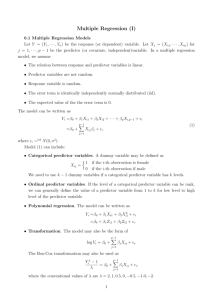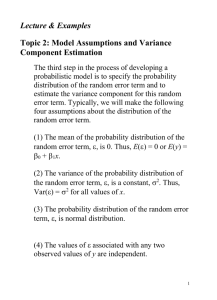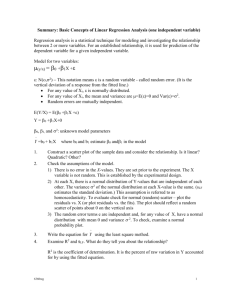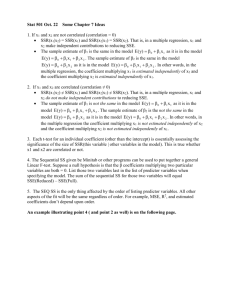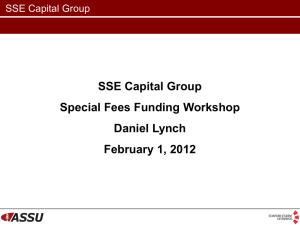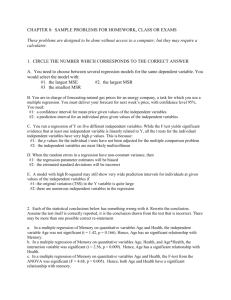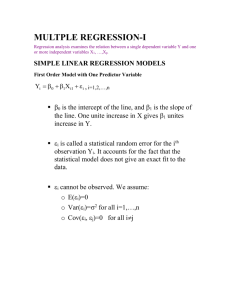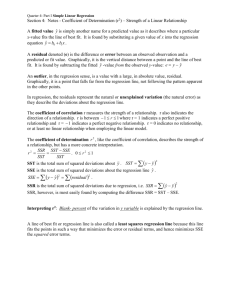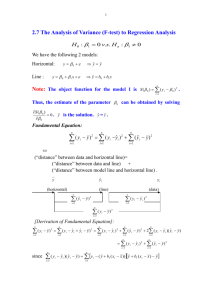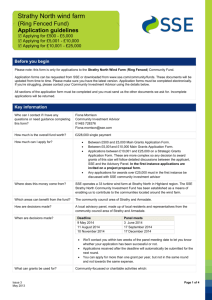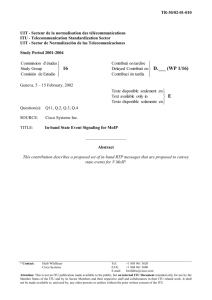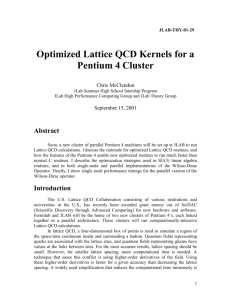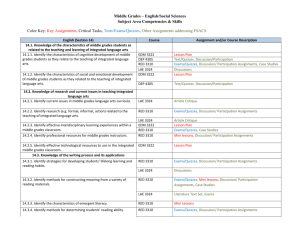Oct. 8 Handout
advertisement
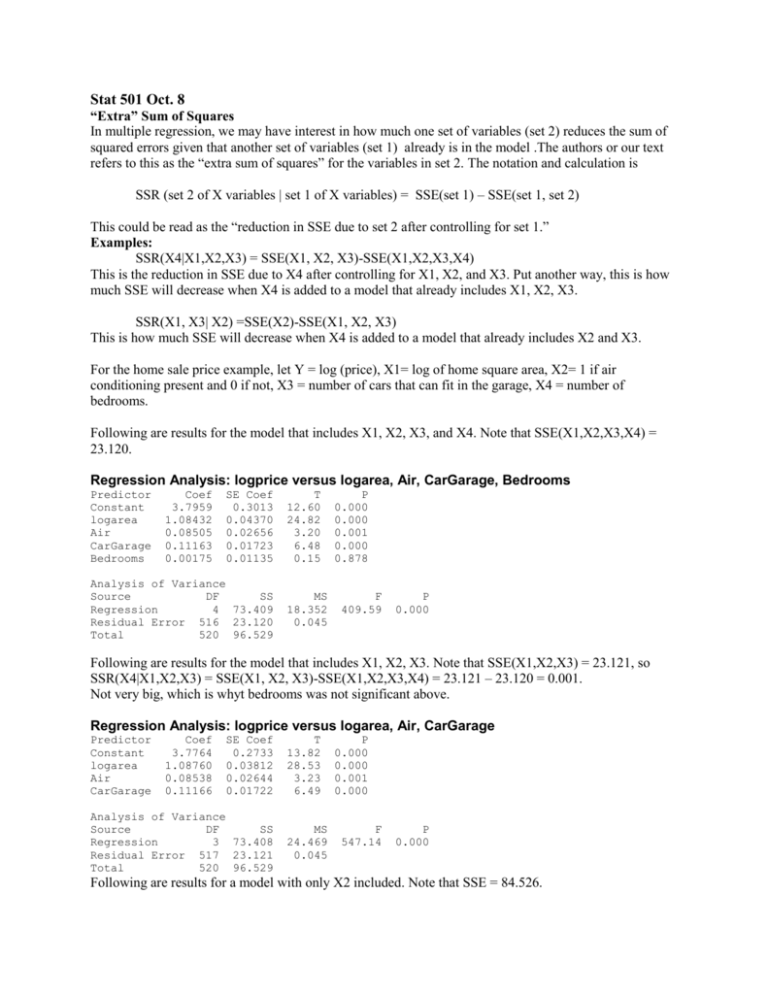
Stat 501 Oct. 8 “Extra” Sum of Squares In multiple regression, we may have interest in how much one set of variables (set 2) reduces the sum of squared errors given that another set of variables (set 1) already is in the model .The authors or our text refers to this as the “extra sum of squares” for the variables in set 2. The notation and calculation is SSR (set 2 of X variables | set 1 of X variables) = SSE(set 1) – SSE(set 1, set 2) This could be read as the “reduction in SSE due to set 2 after controlling for set 1.” Examples: SSR(X4|X1,X2,X3) = SSE(X1, X2, X3)-SSE(X1,X2,X3,X4) This is the reduction in SSE due to X4 after controlling for X1, X2, and X3. Put another way, this is how much SSE will decrease when X4 is added to a model that already includes X1, X2, X3. SSR(X1, X3| X2) =SSE(X2)-SSE(X1, X2, X3) This is how much SSE will decrease when X4 is added to a model that already includes X2 and X3. For the home sale price example, let Y = log (price), X1= log of home square area, X2= 1 if air conditioning present and 0 if not, X3 = number of cars that can fit in the garage, X4 = number of bedrooms. Following are results for the model that includes X1, X2, X3, and X4. Note that SSE(X1,X2,X3,X4) = 23.120. Regression Analysis: logprice versus logarea, Air, CarGarage, Bedrooms Predictor Constant logarea Air CarGarage Bedrooms Coef 3.7959 1.08432 0.08505 0.11163 0.00175 SE Coef 0.3013 0.04370 0.02656 0.01723 0.01135 Analysis of Variance Source DF SS Regression 4 73.409 Residual Error 516 23.120 Total 520 96.529 T 12.60 24.82 3.20 6.48 0.15 MS 18.352 0.045 P 0.000 0.000 0.001 0.000 0.878 F 409.59 P 0.000 Following are results for the model that includes X1, X2, X3. Note that SSE(X1,X2,X3) = 23.121, so SSR(X4|X1,X2,X3) = SSE(X1, X2, X3)-SSE(X1,X2,X3,X4) = 23.121 – 23.120 = 0.001. Not very big, which is whyt bedrooms was not significant above. Regression Analysis: logprice versus logarea, Air, CarGarage Predictor Constant logarea Air CarGarage Coef 3.7764 1.08760 0.08538 0.11166 SE Coef 0.2733 0.03812 0.02644 0.01722 Analysis of Variance Source DF SS Regression 3 73.408 Residual Error 517 23.121 Total 520 96.529 T 13.82 28.53 3.23 6.49 MS 24.469 0.045 P 0.000 0.000 0.001 0.000 F 547.14 P 0.000 Following are results for a model with only X2 included. Note that SSE = 84.526. So, SSR(X1, X3| X2) =SSE(X2)-SSE(X1, X2, X3) = 84.256-23.121 = 61.135. Adding X1 and X3 to a model that had only X2 will decrease the SSE by 72.135. Regression Analysis: logprice versus Air Predictor Constant Air Coef 12.0965 0.40512 SE Coef 0.0430 0.04719 T 281.18 8.58 P 0.000 0.000 Analysis of Variance Source DF SS Regression 1 12.003 Residual Error 519 84.526 Total 520 96.529 MS 12.003 0.163 F 73.70 P 0.000 Testing Whether One or More Variables Can Be Dropped From the Model A statistical test of whether a set of variables can be simultaneously eliminated as predictor variables is based on the F-statistic SSE (Re duced) SSE (Full ) error df for reduced - error df for full F= MSE (full ) with df = (error df for reduced – error df for full) and error df for full. . The precise null hypothesis is that some specified set of coefficients is 0. The Reduced model is the model that results if this null hypothesis is true. The Full model is the model with all variables being considered included. Example: Suppose a potential model is y i o 1 x i1 2 x i 2 3 x i 3 i . This is the “full” model. If we wish to test H0: 1 3 0 the reduced model is y i o 2 x i 2 i Basically, we’re testing to see if variables x1 and x3 are “significant” given that x2 will be in the model. The relevant F-statistic is SSE( x 2 ) SSE( x 1 , x 2 , x 3 ) SSR ( x 1 , x 3 | x 2 ) error df reduced error df full error df reduced error df full F MSE ( x 1 , x 2 , x 3 ) MSE ( x 1 , x 2 , x 3 ) Tasks we’ll complete in class: 1. Consider the home price example with a full model of X1,X2,X3. Calculate an F for testing H0: 1 3 0 2. Consider the home price example with a full model of X1,X2,X3, X4. Calculate an F for testing H0: 4 0
